|
Rat Agility Equipment
also Gerbil/Hamster/Mouse Agility Equipment (scroll down)
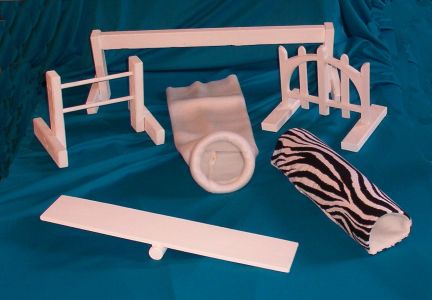
There are so many fun pieces of rattie equipment these days. Most have been adapted from dog agility, and dog agility ideas started with Steeple Chase or Show Jumping or in fact Showjumping....a horse sport where all other animal species agility originated. The horses jump Fence Jumps, jumps set up to look like beautiful fences you might see in the open county. This is why many flaks call all animal agility equipment "fences".
All equipment must be sturdy and safe for the normal use of how the equipment was designed. The agility equipment must be made to rat size and be painted or treated in a way that it can be easily cleaned between runs if necessary. Make sure all items are sanded so that there are no sharp edges. However, natural wood (including bark) may be used to design Rat Agility Equipment it may be sprayed or painted with varnish or shellac. Equipment is to be set up on a sturdy table (absolutely no wobbling) or two tables pushed together that are the same size.
At the bottom of this page you will find some items that could be used for young rats, hamster agility and or gerbil agility to learn to run an Agility Course.
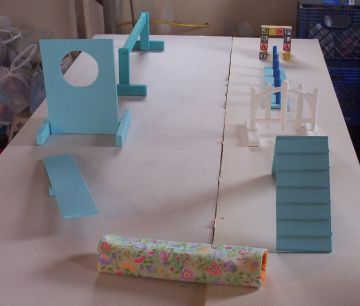
Animal, for all species, Agility Equipment can be painted and made with bright and colorful colors. Competitors (the people ones) and Spectators alike enjoy fun looking equipment. You can do many different things to make your equipment more eye appealing. Just keep in mind that the equipment does need to be washed down frequently. Use only paints and fabrics that will hold up under the conditions of urine and soaps. Have fun with it. Part of the fun in Agility is the equipment.
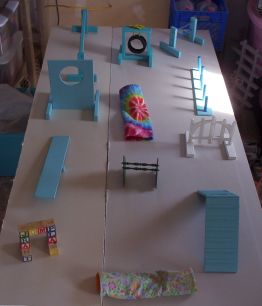
Where can you buy small animal agility equipment? We do offer some rat agility items here on this site and will offer more items soon. Check our Rat Items
For Sale page. We do have and will have more Hamster, Gerbil, Mice, Mouse, and other small animal Agility Equipment on our Small Animal Fun site.
This page is a work in progress. My husband and I are still coming up with new ideas for new pieces of equipment. Photos, sizes and ideas still coming, please check back often. I am blessed, all of the photos you see on this site, unless noted, are of our animals and our items. We made all of the agility equipment you will see on this and our sister sites. All photos (as noted on all our pages at the bottom) are copyrighted.
 THE HOOP JUMP You will need a hoop that is 6" to 8" in diameter. It can be made of wood, plastic or fabric. However, if it is made of fabric there will need to be four (4) replacement hoops for competition in case one or more rats pee on the fabric. The frame holding the hoop can also be made of wood or plastic. The frame will be " X " and made to be sturdy and very balanced so that it will continue to stand even if "hit" by the rat as the rat comes through the hoop.
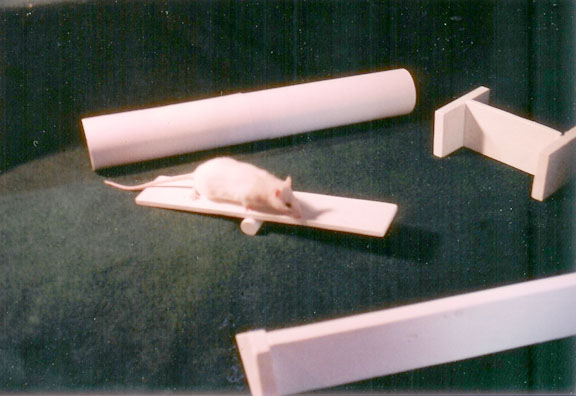 TEETER TOTTER TEETER TOTTER
The Teeter Totter is a smaller type Sea Saw. The top board is 16" X 3" and it pivots on a wooden dowel that is 3/4" in diameter and 3 1/2" long. The top board is secured to the wooden dowel by first gluing then tacking with small tacks from the board side down. Paint with non toxic water proof paint and decorate if desired.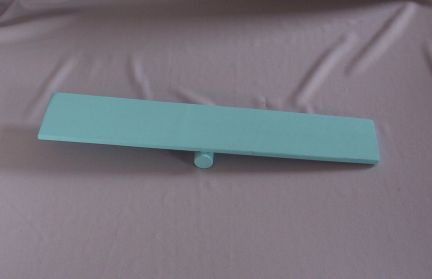
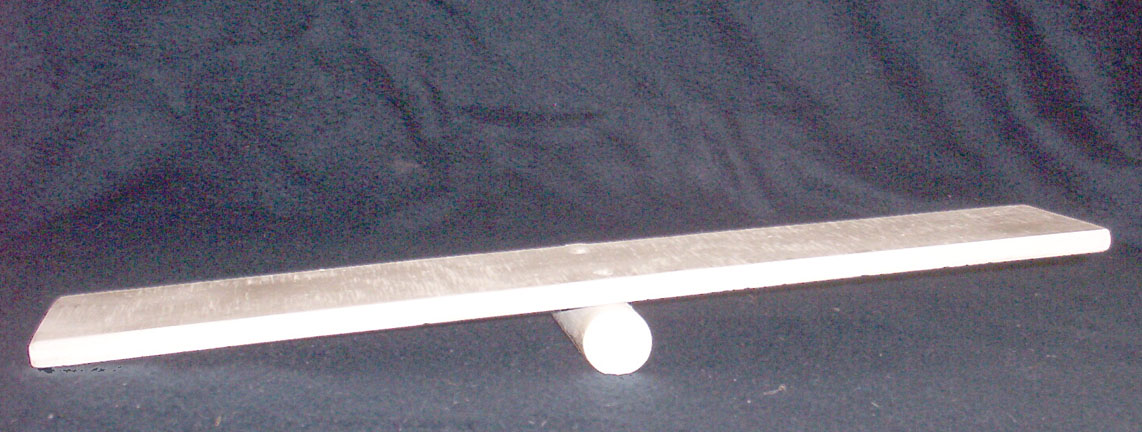

SEA SAW
The Sea Saw is a favorite piece for both the owners of the rats as well as those watching the rattie run the course. Be sure to put safety first. The Sea Saw you use needs to be stable and break over (teeter) easily and quietly.
This one has a platform that is 20" long and 3" wide, it is attached to a stand that is 8" x 3" high. My husband made sure that it was both balanced, tipped back to the same side when rattie steps off and he made it "feet safe" before painting it so that it could easily be cleaned thoroughly.
WALL JUMP

The Wall Jump is a fun jump, rats take to it right away. It is also easy to make.
This one is 8 1/2" long x 3 1/2" tall, the ends are approx. 5" x 3 1/2". It, like our other equipment is painted so that it can be cleaned easily.
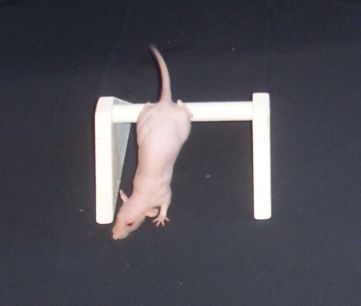
STATIONARY BAR JUMP
I have to laugh when I see this one.....it reminds me of a toilet paper holder.
The Bar Jump is basically a stand, approx. 8 1/2" x 3 1/2" with a 3/4" towel cut to 6 1/2'. My husband screwed the dowel in and painted it white.
A Stationary Bar Jump has a bar that is attached in a manner that it can not be moved or adjusted.
The rat coming over it is our rattie The Ballerina, at the time of this photo she is about 6 months old and a Hairless Dumbo Rattie.
 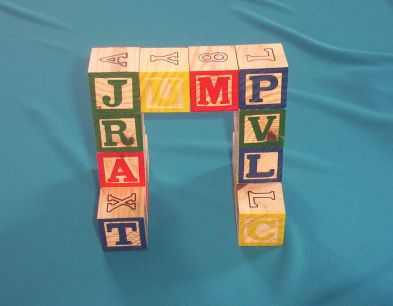
This is a fun Stationary Bar Jump. It is made with human baby wooden alphabet blocks. You can write messages, ratties names, agility cues or whatever your heart desires with these.....as long as they are short messages.
I think these types of jumps make the agility course fun.
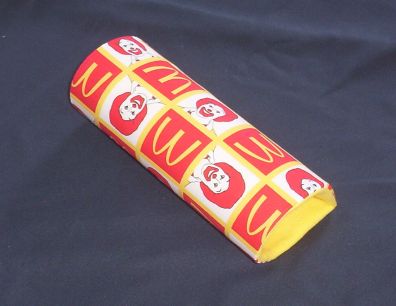 OPEN TUNNEL OPEN TUNNEL
An Open Tunnel can be made of plastic, fabric over plastic or PVC. The size must remain consisting throughout the entire tube. with no collapsible parts. The opening must be a minimum of 3" and maximum of 5". It should be 12" - 18" in length. The outside may be decorated.
This one is a cotton type print on the outside with a fleece inside. It is washable.
I like this print....reminds me of Drive Thru. LOL Where else would a rat love to go? I'm Lovin' It. LOL
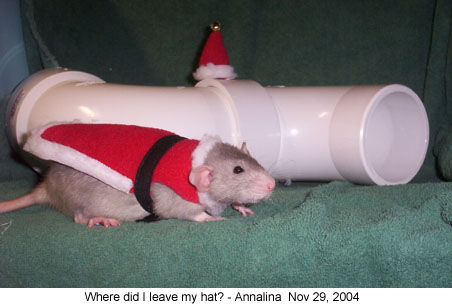 OPEN S SHAPED TUNNEL
This is an Open Tunnel shaped into an "S". It is a fun piece of equipment for both spectators and the rats.
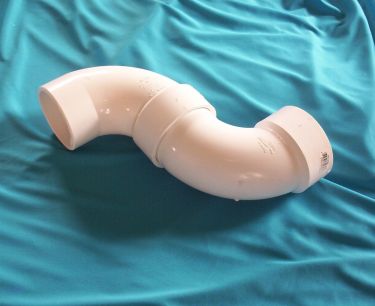
We like to use PVC piping for these, it is easy, cheap and easy to clean. We used two 90 degree elbow plumbing PVC pieces and placed them together.
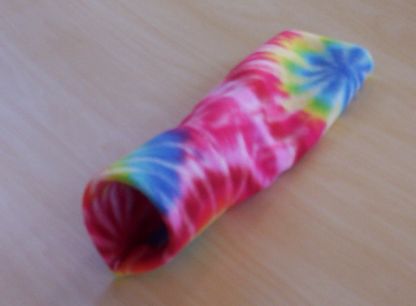
CLOSED TUNNEL
A Closed Tunnel can be made of fabric or "quiet" plastic, but it must be washable.
If a fabric closed tunnel is used in competition there must be at least three (3) closed tunnels available for the rats to use. This is so that if rats soil one another can be used. The of the Tunnels surface must not be slick.
A Closed Tunnel must have a "stiff" opening that is 4" to 5" in diameter with a 15" "drape" that is one piece flow. The drape can be sewed or taped but must be made into one piece.
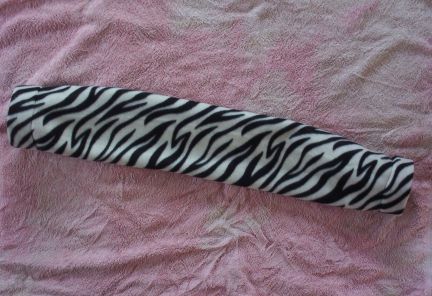
DOUBLE OPEN ENDED CLOSED TUNNEL
This Tunnel can be used in an Agility Course but is more of a training tool then an official equipment piece.
The Double Open Ended Closed Tunnel (DOECT) is approx 4" x 18", the middle area drapes like the Closed Tunnel would. I made it with the same type good grade polar fleece.
I was having trouble getting a young doe (Nineveh) to come all the way through the Closed Tunnel so I did two things. I made this piece, it has wider openings on each end but drapes in the middle section for her to use. This way she could see the opening and I could reach in if I needed to to "help" her on through.
I also worked a bit more on the "Shoulder" command. This is where I put my hand down on the table/cage/desk and tell the rattie "shoulder" and they learn to run up my arm to sit on my shoulder.
Between the double open ended tunnel and having my hand where she could see it at the end of the tunnel, she learned to come through the tunnel reliably.
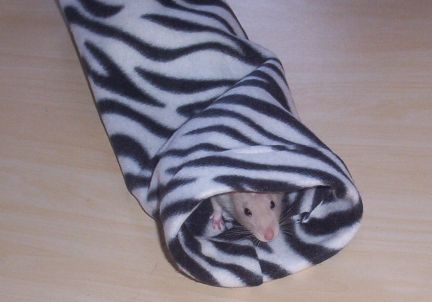
After you have the rattie coming through the Double Open Ended Closed Tunnel (DECT) you can switch the piece back to the Closed Tunnel or just continue to use the DOECT.
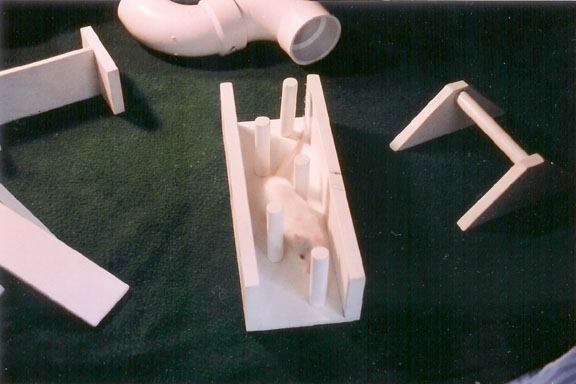
WEAVE POLLS
I have seen Weave Polls made in several different ways. Some I like better then others. My husband and I designed these and it works well for the way we train.
The first one (white) Weave Poll piece has such a nice stable base. It will hold the ratties weight if the rat stands on either of the sides. You do want your Weave Polls to be very safe for your rats, if a poll falls, especially on a rat, it will/can scare a rat, this will set back all agility training for the scared rat.
A Weave Poll set up should have five polls. The polls can be staggered or straight. The staggered polls can be set closer to one another then the polls are set in a straight line....obviously because of the ratties body style.
The white set is on a base that is 16" x 6". The 3/4" Polls are placed just over 3" apart and staggered.

The Blue set is made a bit different. It is a set we worked on to make sure it was safe for the ratties and light weight for shipping. This one is almost 16" and 3" wide. It has five "pegs" or polls that set down in drilled, painted holes in the base itself. The polls can be pulled out for easy storage.
The polls in this set are just over 3" apart, center to center. For larger ratties I would recommend setting the Weave Polls approx. 4" center to center apart.
You do need to make sure that your Weave Polls and any other equipment is painted or waterproofed so that if the rat would urinate on it the piece can be cleaned quickly and thoroughly.
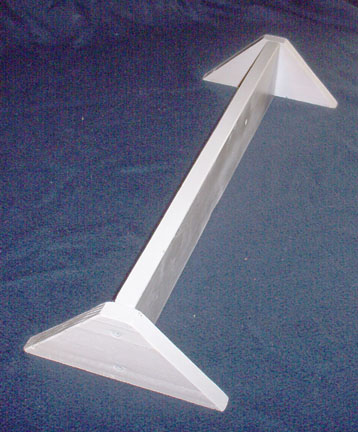 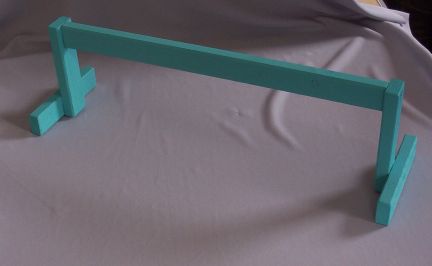
BALANCE BEAM
Our White Balance Beam is 3 1/2" tall and 22" long. It is made of pine wood. Our ends are made large enough (8" at the longest part) to be stable for the ratties weight.
The Turquoise Balance Beam is the type we sell at this site in a set. It is approx 6" high and 19 1/4" long. It has been made stable and safe and yet light weight for shipping.
We have painted ours, but any type waterproofing (for pee) so that it can be easily cleaned is a good idea.
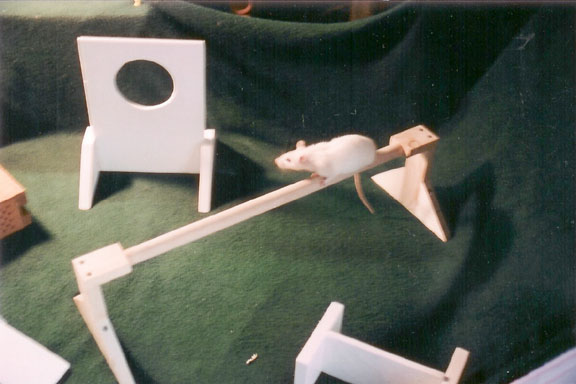
HIGH BEAM BALANCE BEAM
The High Beam Balance Beam is a bit higher and harder for the rattie then the regular Balance Beam.
The High Beam Balance Beam is made with a 1" wooden dowel placed between two end piece stands.
The High Beam Balance Beam is approx " long and " tall with a " x " base.
Sugar, my first Agility rattie is the one pictured her.
 LONG JUMP
The Long Jump can be made in a variety of lengths. Most, for competition are approx 12". That said the overall size of the piece is approx. 20" so that the rests are attached securely to the base of the piece.
I recommend that the piece has an extra 4" x 2" piece that can be moved between the two ends for training. The idea being the jump is shorter to start and grows as the rat learns that you want it to jump between the rests rather then walk or run the piece.
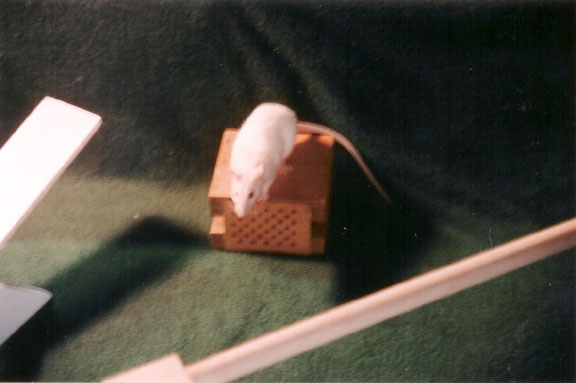
PAUSE TABLE
The pause table should be a maximum of 4" tall and the table top should be approx 6" X 6". The legs should be set to give the table the utmost stability.
This one is just over 3" tall and just over 5" x 5".
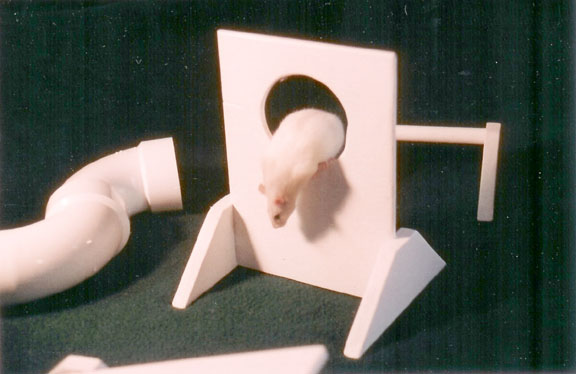
WINDOW JUMP
The White Window Jump is a three piece wood item. The hole for the rats to go through is 5" from the bottom/floor and 2" from each side. The hole itself is a 4 1/2" hole. On each side of the window a piece of wood cut to and glued and/or nailed to the window so that they are centered and will steady the window for the rat to climb, hop or jump through without knocking the piece over. The wood piece that the hole is cut out of is approx. 8 1/2" x 12"....and painted for easy cleaning.
The turquoise Window Jump is 11" tall, 8" wide, with legs that are also 8" long. The window hole is a 4" diameter. This jump was made to be light weight for shipping, yet stable and safe for the rats weight when going through it.
 OVER UNDER
 CROSS JUMP
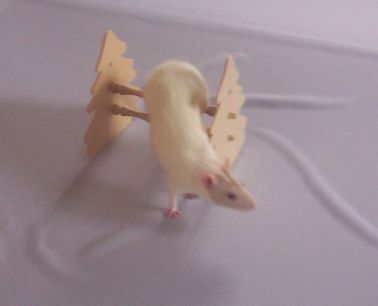
BAR JUMPS
Bar Jumps can come in many shapes and sizes. The important thing is that they stable and set for a fair height.
Bar Jumps are made so that the bars are adjustable. Each side of the jump must match the other so that the adjustments are even when set up.
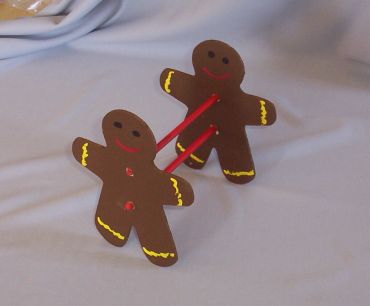
You can see in this photo with Nineveh coming over the Bar Jump that I have two bars on the jump and the jump has three holes. The bar could be raised.
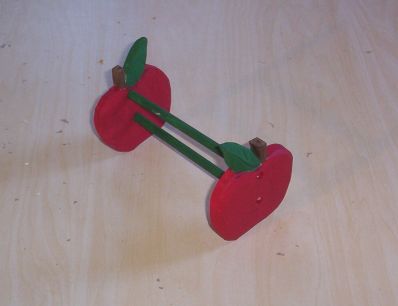
Bar Jumps (for any agility species) are often times made up very artsy and will quickly catch your eye on the Agility Course. (Mine are not, I don't have the talent.) Bar Jumps are often times wood cut out into shapes and painted in detail. Some are very fancy including the bars into the art of the piece. If you scroll down to the Small Animal Equipment on this same page you will see that I have painted this Tree Bar Jump green. I took the photo here while I was checking the jump for stability for the rats weight.
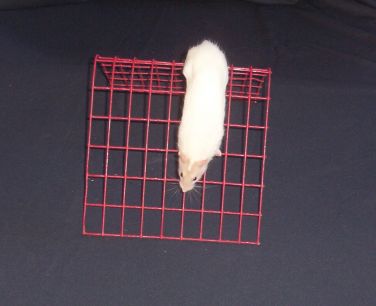
 WIRE A FRAME You can use any type of wire that is strong enough when folded to hold a large fancy rats weight while climbing the piece. I used 1" x 2" wire and a piece that is 9" x 24" with the bottom of the pieces base edges approx 12 1/2" apart (after folding).
I folded the piece in half by bending it over a wooden stand. I then painted the piece and let it dry well (duh!!) before letting my fancy rats give it a whirl. This is a piece they LOVE!!

"A" FRAME
I love this piece. This is a little wooden "A" Frame designed just like the ones made for training police, search and rescue and re dogs. Dog Agility adopted this piece I am assuming because it is such a fun piece for both the dogs and the spectators to see. It is also a proud moment for the animal owner when your pet runs over this.
The animals are suppose to "touch" the bottom part of both sides of this piece. ie, They are not suppose to jump up on the middle or jump from the top or middle. They are to manipulate the entire piece. In dog agility there is an area at the bottom of both sides that they must "touch" or they will be DQed or have points added to their score. You will notice in Dog Agility that the area is painted yellow so that there is no doubt if the animal "touched" that area.
This Rattie "A" Frame is approx. 4 1/2" side with 10" sides. It has hinged to open and close this piece so it stores flat. My husband scaled it down from the dog piece. We painted this one light blue so it can easily be wiped down if it would need to be.
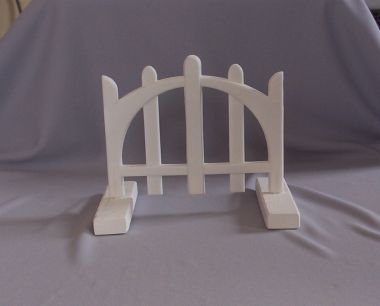
FENCE JUMP
Fence Jumps are made to look like a fence that a horse would be behind in the country. Why? Because all animal agility, all, meaning dog, cat, rat, gerbil, mouse all or any species came from the idea of Steeple Chase. An event horses compete in by jumping over all kinds of pretty and functional fences...well, cut outs if you will.
So you will see, even in mice agility, fence jumps on about every agility courses. This is also the reason some folks call all the jumps "fences".

 TIRE JUMP You can use a small tire shaped dog toy for this. They come in many sizes, make sure you buy one large enough for a large fancy rat to get through. Build a frame for the tire and use cord to tie the rope to the frame at the height you desire. Make sure the frame has feet for stabilization of the piece so that the fancy rats can climb on it and the piece will hold even a large fancy rats weight.
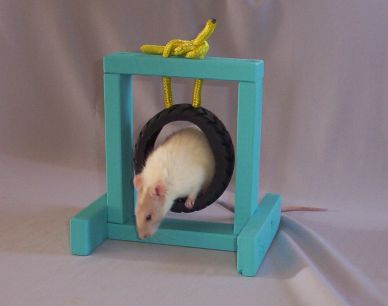
This one has Nineveh our Fancy Rat coming through it. I have to make a note of who is who, she looks so much (at first glance) like Sugar....and Sweety. Can you tell I "need" some darker colored ratties too. LOL
 LADDER WALK The Ladder Walk is made easiest by buying 3 " parrot ladders at a local pet store and (this was terminated here on the old website. What happened Marna?)
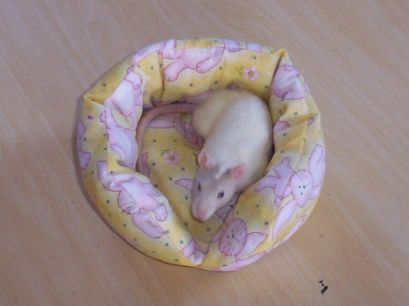
A NICE SOFT BED
And when training and events are over, make a big fuss over your rattie and give it a few good treats, then make sure it has a nice warm comfortable place to sleep.
HAMSTER/GERBIL AGILITY EQUIPMENT (also YOUNG RAT)
Dwarf Hamster/Mouse Agility Equipment Below
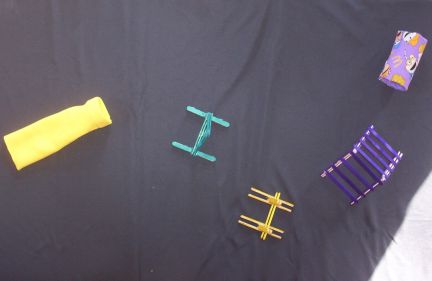
Any items you use as agility equipment for your Gerbils needs to be stable enough for the gerbils weight and have no sharp edges. The pieces of equipment need to be the right size for gerbils. Some Rat or Rattie Agility pieces of equipment may work for your gerbil but for the most part these items will be too large. You may be able to use a couple of items a mouse would use for agility, but most of these items will be too small. Just like Goldie Locks, your gerbil needs the right sized "stuff".
You can buy items already made up or make some yourself.
Items as simple as a empty cardboard paper towel roll can become an Open Tunnel or a Sea Saw Tunnel.
Many gerbils only jump. They have a series of different jumps that they seem to fly over. This is really called "ShowJumping or Show Jumping". It takes a bit more training to teach the gerbil to use the agility equipment....under, over, around and through. It does not matter what you choose, the gerbil will have fun either way.
The above photo is of how an agility course for a gerbil or hamster might be set up.
Gerbil or Hamster Agility Equipment Pieces
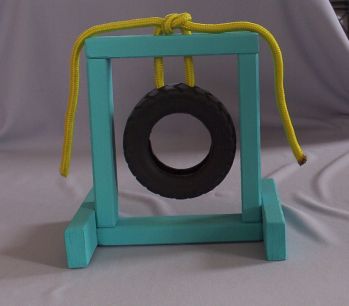
TIRE JUMP
This jump is made with a small dog toy tire tire and frame. It is one of the cutest pieces (in my opinion). It must have a stable frame to hold the gerbils weight should the gerbil climb through this piece, in training, rather then jumping through it.
The rope holding the tire will be cut to size as soon as I decide where exactly I want the tire to hand.
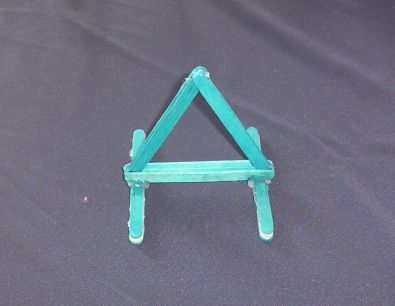
HOOP JUMP
Same basic Jump as the Tire Jump but made with any type hoop/ring....needs to be very stable.
Hoops are usually but not always round.
The hoop jump for a gerbil can be made of many cute items. Just make sure that the frame does hold the hoop well and is stable enough for the animal to climb on while first learning the piece. Some gerbils and most hamsters will always climb rather then jumping the Hoop Jump.
WINDOW JUMP
Window Jumps are much like a Hoop Jump but the background is solid. In other words the Window Jump is made with a solid piece of wood or plastic with a "window" cut out for the animal to jump through. Most of the "windows" are made larger then a typical "hoop" would be for a Hoop Jump.
Window Jumps can be any shape but usually are rectangle with the long side facing up and down.
This piece, the Window Jump, is a real crowd pleaser in events.
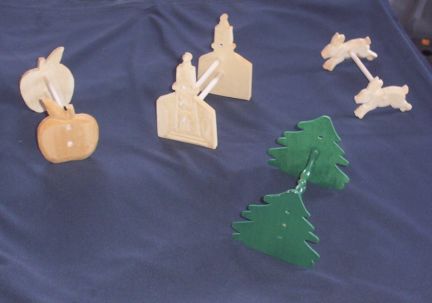
BAR JUMPS
Bar Jumps can come in many shapes and sizes. The important thing is that they stable and set for a fair height.
The Bar Jumps should also be the right size for the animal. In other words, you would not want to use a set of Bar Jumps for your Gerbil or Hamster that were made for a Rabbit. A Dwarf Hamster might need smaller Bar Jumps then a Gerbil would. Certainly a Dwarf Hamster would need smaller equipment then a rat.
Bar Jumps are made so that the bars are adjustable. Each side of the jump must match the other so that the adjustments are even when set up.
These Bar Jumps (for any agility species) are usually where you see the Agility Art, if you will, on the Agility Course. Bar Jumps are often times wood cut out shapes and painted in detail. Many times the bars themselves are part of the art.
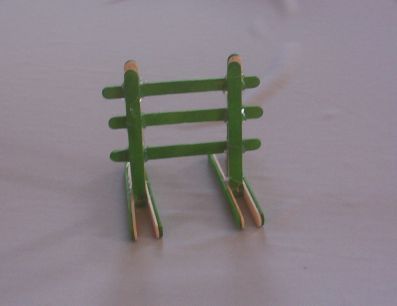
STATIONARY BAR JUMPS
Stationary Bar Jumps are Bar Jumps with stationary bars...or bars that do not adjust.
These Bar Jump is made with colored Popsicles Sticks and is stationary enough to support a gerbil, hamster, mouse, or young/baby rat.
Gerbils use lots of jumps in their courses because jumping them is fun for the gerbil.

FENCE JUMP
Fence Jumps are made to look like a fence that a horse would be behind in the country. Why? Because all animal agility, all, meaning dog, cat, rat, gerbil, mouse all or any species came from the idea of Steeple Chase. An event horses compete in by jumping over all kinds of pretty and functional fences...well, cut outs if you will. The event can also be called "Show Jumping".
So you will see, even in mice agility, fence jumps on about every agility courses. This is also the reason some folks call all the jumps "fences". Many people also refer to the small animals agility or jumping courses as "Show Jumping".
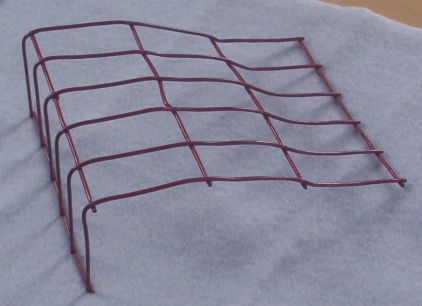
WIRE "A" FRAME
For this Wire A Frame you may want to use a smaller sizing in the webbing of the wire. I like the larger wire as it teaches the smaller animals to reach (LOL once you teach them not to go through the wire and hang upside down)
These are two I use (photos coming soon). The first is approx 8" x 5" and is bent over at the first "squares" of the wire. I have found this size to be great for teaching the young ratties for the first time on a Wire A Frame.
The second is approx. 8" x 8" and is also folded at the first "squares". Both of these I have painted red with spray paint.
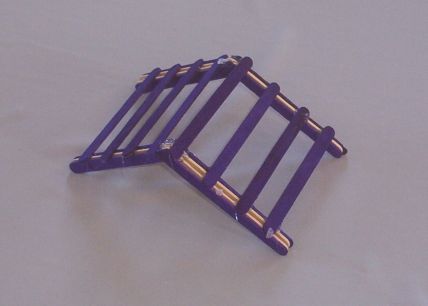
"A" FRAME
An "A" Frame is a "walk", if you will, that from the end is shaped like a capital letter A. It has some sort of planks, slats, or steps for the animal to climb up one side and down the other.
This piece is usually a favorite with animals....dog, cats, rats, mice, most animals really enjoy scaling the "A" Frame.
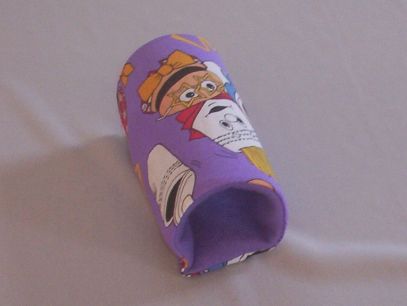
OPEN TUNNEL
For an Open Tunnel for a young (small) rat or a Hamster or Gerbil, 2" PVC pipe works well. It is light weight, easy to clean and can be painted or decorated if you desire.
Or you can use a fabric Open Tunnel. This one is a McDonald's Restaurant fabric print with purple polar fleece lining. It is approx.5 1/2" long with a 2 1/4" opening. It is machine or hand washable and I can let it air dry.

CLOSED TUNNEL
The Closed Tunnel should have one end open and a drape in the "fabric" with a closed end.
This one I use for my hamster and gerbil. It is approx 10 1/2" long with a 2 1/2" opening. It is made with polar fleece that is washable.
BALANCE BEAM
The Balance Beam can be as simple as a plank or as elaborate as a slated bridge with picket sides.
For a gerbil the platform that they run across should be approx. 2" wide. It might be as long as 18-20" or as short as 6". The Balance Beam should be approx 3-4" tall. It will need to be painted so that it can be cleaned easily.
WEAVE POLLS
Weave Polls are a series of 5 to 7 polls that the gerbil will "weave" through. The polls are set up in a row, some staggered, and the gerbil walks to the left of the first, right of the second, left of the third and so on.
I have seen some really cute ideas for tiny Weave Polls. I have seen Playdough used to hold polls, small dolls used, toilet paper rolls, the ideas are endless.
Make sure that the stand or platform that you attach your Weave Polls to is stable. The gerbil, fast as they are, may bump into a poll or two and they need to stay upright and not fall over on or near the gerbil and scare it.
When your gerbil masters this piece it is really cute to watch them run through it. It will take a lot of training, so stay patient and have fun.
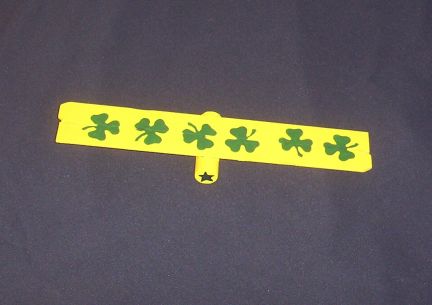
TEETER TOTTER
Teeter Totters are a fun piece of agility equipment. Everyone loves the Teeter Totter. Make sure while training this piece to your animals that you go slow and keep it low until they get used to the teeter. remember, when they first begin, it feels like the ground is dropping under them.
A Teeter Totter for a mouse should be approx. 2" x 15". The teeter should not be more then 2" and 1 1/2" would be best.
The Teeter Totter like all pieces should be painted with a paint that can easily be cleaned with a wipe.
The Teeter Totter is smaller then the Sea Saw and should be taught to the animal first. Take your time training this piece. If not trained slowly it could set back your entire training as it might scare the animal.
SEA SAW
The Sea Saw is a favorite piece. Everyone wants it tall and fun. For a well trained gerbil a taller, but not too tall Sea Saw is fun. But it must be taught correctly.
The piece should be approx. 3" wide, by 12" - 15" long with a 2" pivot, or teeter (break over).
The piece must be stable or wide enough to hold the animals weight even if the animal is running off center.
Remember to train the gerbil to the Teeter Totter first. The Teeter totter is a shorter Sea Saw. Remember when the gerbil walks on the Teeter Totter or Sea Saw, it feels like the ground is dropping under it when it pivots. Take training for this piece slowly, it will be worth it.
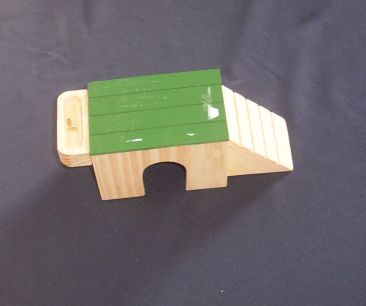
PAUSE TABLE
Usually a Pause Table is a small table type area for the animal to stop on. Sometimes it is the ending piece for the animal and when it arrives it will get a treat at that or on that piece.
Many times the Pause Table is a plastic or wooden box. I have also seen large lids used for the tiny animals for Pause Tables.
This one is a cute little wooden house with a treat bowl built in.
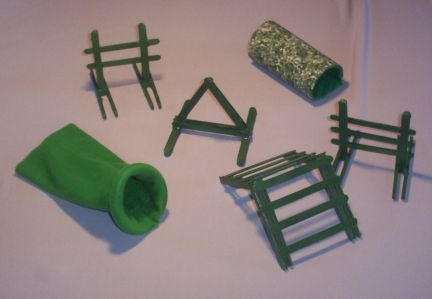
SMALL ANIMAL SEVEN PIECE AGILITY SET
This seven piece set (including the plastic storage box the items come it) is a great starter set for gerbils, regular and dwarf hamsters, mice, mouse, a small or very young rat, rattie, rats.
It comes with two Stationary Bar Jumps, one with two bars the other with three bars, a Triangle Hoop Jump, an A Frame, and a fabric Open Tunel as well as a fabric Closed Tunnel.
While not competition equipment, still fun and functional and great for training and having a great time at home or with friends that also own small animals. It is also recommended for entertaining friends and family with your small pets antics!!
We sell these in our on site stores to encourage people to get started in this fun and exciting sport....small animals love the equipment and the time spent with you.
You can use it just as it is and or add jumps and other equipment as your small pet learns to manover the course you set up for it.
The contents of this page for Gerbil Agility Equipment is still under construction. Please check back later!
MOUSE/MICE/DWARF HAMSTER AGILITY EQUIPMENT
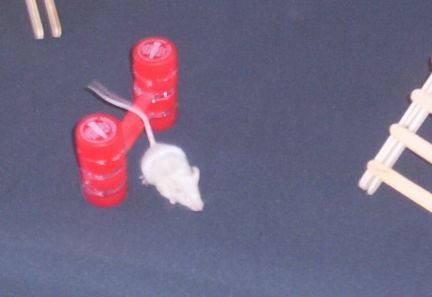
Mice can be easy to train for or to agility because they naturally run along a wall and run the same way each time. If you set your agility course up along a wall or make a short wall (books or wood or even using a sheet of paper to guide the mouse along the course) will help in training.
The equipment needs to be mouse size, not too big and not too small. It needs to be stable enough and safe enough for your mouse to run on and it not tip over or collapse on or with the mouse. Make sure there are no sharp edges on any of the equipment. Decorate to add a touch of fun and train away.
If you have ever trained dogs for agility and hauled their equipment...you will love mouse agility. Most of the course will fit into a shoe sized storage box. Several of the pieces will fit into your coat pocket.
Mice do need their own set of agility equipment. They will not share well with your hamster or other small animals. Mice have this thing about smelling other animals on their stuff and the might just think that the animal they smell is near and out to hurt them (think like an animal, the little mouse thinks it may be killed and eaten).
Mice can be great pets. If you work with them you will find training easier the you first think. Most mice enjoy spending time with their owners too. So the more time you spend together the more your little bitty pet will learn.
While Mice and Dwarf Hamsters can use some of the same sized items a gerbil or hamster agility equipment, they will also need some smaller items or pieces. Just as some of the rat agility equipment is too large for a gerbil, some of the gerbils items are too big for a mouse.
The agility equipment needs to be built well enough to support a mouses weight, remember many, if not all mice, will climb the piece rather then just jump it.
If you build your items make sure you use items that are safe and have no sharp edges. Make sure it will support the weight of the tiny animal in a safe manner. Use safe paints.
If you are teaching your mouse to run an agility course do not let them have the same items in their cage to play on or sleep in. For example, you will have a hard time teaching a mouse to run through a tunnel on a course if they sleep in one in their cage.

FENCE JUMP
Fence Jumps are made to look like a fence that a horse would be behind in the country. Why? Because all animal agility, all, meaning dog, cat, rat, gerbil, mouse all or any species came from the idea of Steeple Chase. An event horses compete in by jumping over all kinds of pretty and functional fences...well, cut outs if you will. The event can also be called "Show Jumping".
So you will see, even in mice agility, fence jumps on about every agility courses. This is also the reason some folks call all the jumps "fences". Many people also refer to the small animals agility or jumping courses as "Show Jumping".
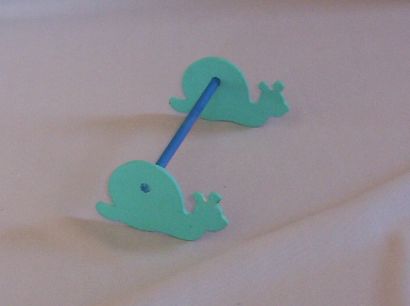
BAR JUMP
Bar Jumps are made with "bars" that are the same height in either side of the matching sides. Most bar jumps are adjustable.
Bar Jumps are usually where you will see the most artsy type jumps at an event. It is fun to make the course a pleasure to look at and have a little fun while making your equipment.
Some but not all Bars are made to fall if hit while the animal is coming over it and hits the top bar.
Be sure to start the animal with low bars when first training these pieces of equipment.
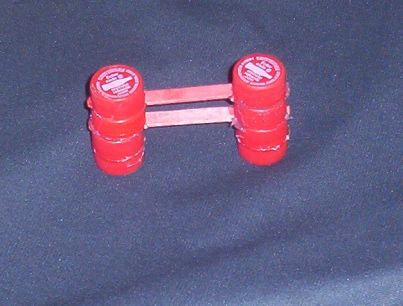
STATIONARY BAR JUMPS
This is a fun little Coke Bar Jump. The jumps do not have to be fancy, but functional and stable.
I have directions on how I made this on our craft page.
The edges look a bit unsightly not because I was sloppy, but that I added glue to the area where the caps were put together to give the jump more strength.
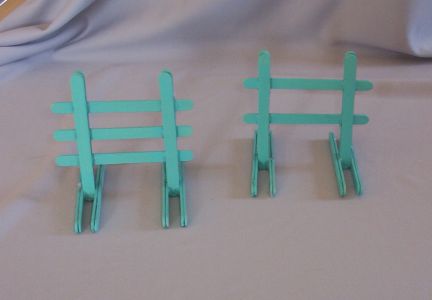
These are two more examples of Stationary Bar Jumps. They could also qualify for a Fence Jump. They work well and are stable enough for a gerbil, mouse or hamster or even a small or young rattie.
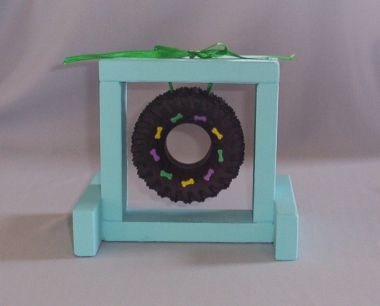
TIRE JUMP
These are cute. It all started when Dog Agility started mounting tires for one of the jumps the dogs jumped through. It was such a cute idea and a big crowd pleaser so the Tire Jump became a staple in a course.
With tires coming in all sizes, including the itty bitty for dog toys, now even mice can have a Tire Jump....and it is a really cute item on the course too!!
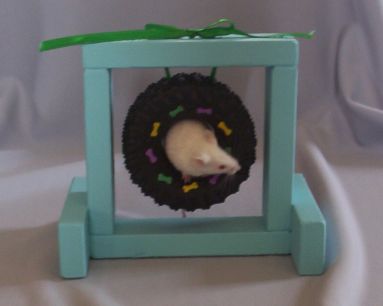
This is Bree our REW mouse coming thinking about coming through the tire. It is the first time she has been in the jump and my thery is that she is seeing things from a little higher up....so what is the hurry to come out.
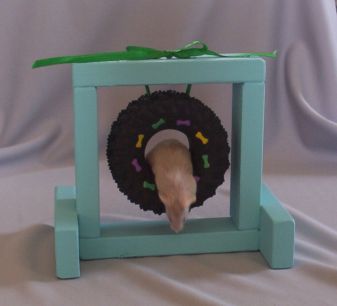
Here is a photo of Red Heart in the Tire Jump. I just think he is the cutest little thing. He loves to "do" an agility course. He likes new equipment and just goes right along. I usually working with ratties, so he is just a tiny little bitty pet.
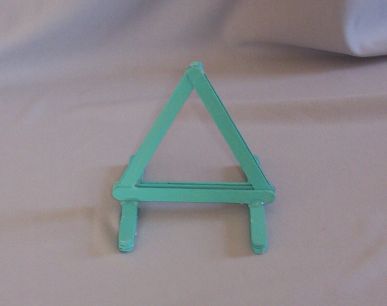
HOOP JUMP
Hoop Jumps are jumps that the animal jumps through. It may have a round or triangle or even square or rectangle shape to it.
The hoop of the jump is a separate piece that attaches to a stand of some sort. Many are very decorative.
For mice there are so many items you can use for the hoop of the jump. Some washers are large enough to use. You do not want something too big or too small.
Most animals will easily be taught to jump through a Hoop Jump.
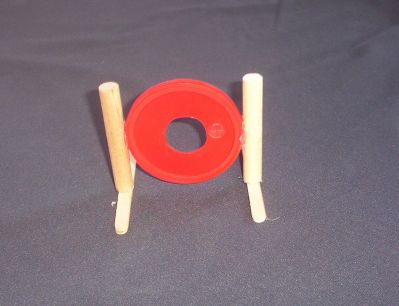
WINDOW JUMP
A Window Jump is a jump made with a solid piece of wood, plastic or fabric with a "window" cute out. Usually the "window" is a bit bigger then say the hoop of a hoop jump.
The Window Jump can be any shape but is usually rectangular with the taller side up and down.
Window Jumps are usually (by any species) climbed when first started and many times always climbed (by small animals).
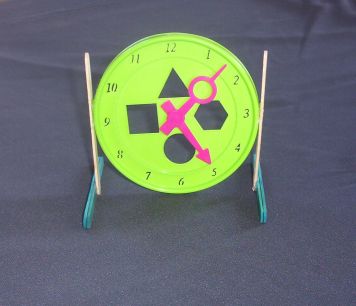
HICKORY DICKORY CLOCK JUMP
OK, so it is really just a Window type jump. LOL
I love this one. It came as a lid on a small bucket full of Lego type lock blocks I wanted to use for small animal agility equipment building....then I got the idea for the Mouse Jump.
So as you can see? You can do a lot with a little. The mouse will jump through this one in the circle above the six on the clock.
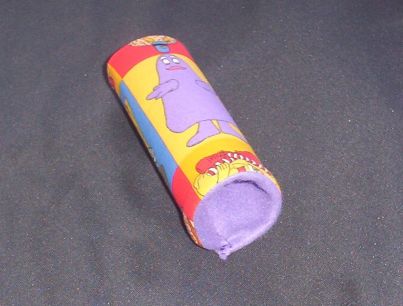
OPEN TUNNEL
An Open Tunnel for a mouse does not need to be much larger then a toilet paper roll.
It should be either plastic, PVC or fabric with a stiff center so that it can be cleaned.
For competition, if using fabric, there should be at least three and surly five that are exactly alike, same color, same fabric, same inside so that each animal has the same experience when they go through it.
This one has a polar fleece center with plastic inside for shaping. I like to use fun fabrics for these items. This one reminds me of Drive Thru or Run Through....it's a hap, hap, happy place...the agility course. <smile>

CLOSED TUNNEL
The Closed Tunnel should have one end open and a drape in the "fabric" with a closed end.
This one I use for my mice. It is approx 8" long with a 2" opening. It is made with polar fleece that is washable.
This is the piece you really have to train for...the small animals run right in to them, the training is to teach them to come out the other end.
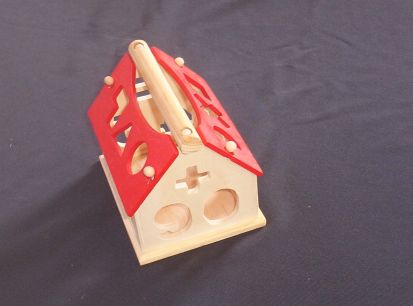
RUN THROUGH
A Run Through is a bit like a tunnel. It is an item that the animal runs through, goes in one way and comes out another, but not a tube or a tunnel.
This one is a Mouse House Run Through. The mouse goes in through the cut out for the 0 and comes out th cut out for the number 6 on the side.
WEAVE POLLS
Weave Polls are a series of 5 to 7 polls that the mouse will "weave" through. The polls are set up in a row, some staggered, and the mouse walks to the left of the first, right of the second, left of the third and so on.
I have seen some really cute ideas for tiny Weave Polls. I have seen playdough used to hold polls, small dolls used, toilet paper rolls, the ideas are endless.
Make sure that the stand that you attach your Weave Polls to is stable. The mouse may bump into a poll or two and they need to stay upright and not fall over on or near the mouse and scare it.

"A" FRAME
An "A" Frame is a "walk", if you will, that from the end is shaped like a capital letter A. It has some sort of planks, slats, or steps for the animal to climb up one side and down the other.
This piece is usually a favorite with animals....dog, cats, rats, mice, most animals really enjoy scaling the "A" Frame.
This little guy is Red Hearts. It is his very first time on the A Frame...I of course think he is as cute as a button!!
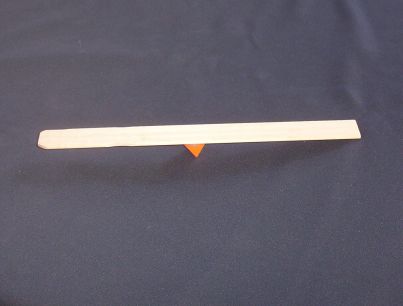
TEETER TOTTER
Teeter Totters are a fun piece of agility equipment. Everyone loves the Teeter Totter. Make sure while training this piece to your animals that you go slow and keep it low until they get used to the teeter. remember, when they first begin, it feels like the ground is dropping under them.
A Teeter Totter for a mouse should be approx. 1" x 12". The teeter should not be more then 1" and 1/2" would be best.
The Teeter Totter like all pieces should be painted with a paint that can easily be cleaned with a wipe.
The Teeter Totter is smaller then the Sea Saw and should be taught to the animal first.
SEA SAW
The piece should be approx. 1 1/2" wide, by 8" - 12" long with a 2" pivot, or teeter (break over).
The piece must be stable or wide enough to hold the animals weight even if the animal is running off center, so when you add height you must also add width to the platform to make it safe for your mouse..
Remember to train the mouse to the Teeter Totter first. The Teeter totter is a shorter Sea Saw. Remember when the mouse walks on the Teeter Totter or Sea Saw, it feels like the ground is dropping under it when it pivots. Take training for this piece slowly, it will be worth it.

THE SET
This seven piece set (including the plastic storage box the items come it) is a great starter set for gerbils, regular and dwarf hamsters, mice, mouse, a small or very young rat, rattie, rats.
It comes with two Stationary Bar Jumps, one with two bars the other with three bars, a Triangle Hoop Jump, an A Frame, as well as an Open Tunnel and a Closed Tunnel.
While not competition equipment, still fun and functional and great for training and having a great time at home or with friends that also own small animals. It is also recommended for entertaining friends and family with your small pets antics!!
We sell these in our on site stores to encourage people to get started in this fun and exciting sport....small animals love the equipment and the time spent with you.
You can use it just as it is and or add jumps and other equipment as your small pet learns to maneuver the course you set up for it.
| 



 In the high plains of South Dakota, USA
In the high plains of South Dakota, USA In the high plains of South Dakota, USA
In the high plains of South Dakota, USA